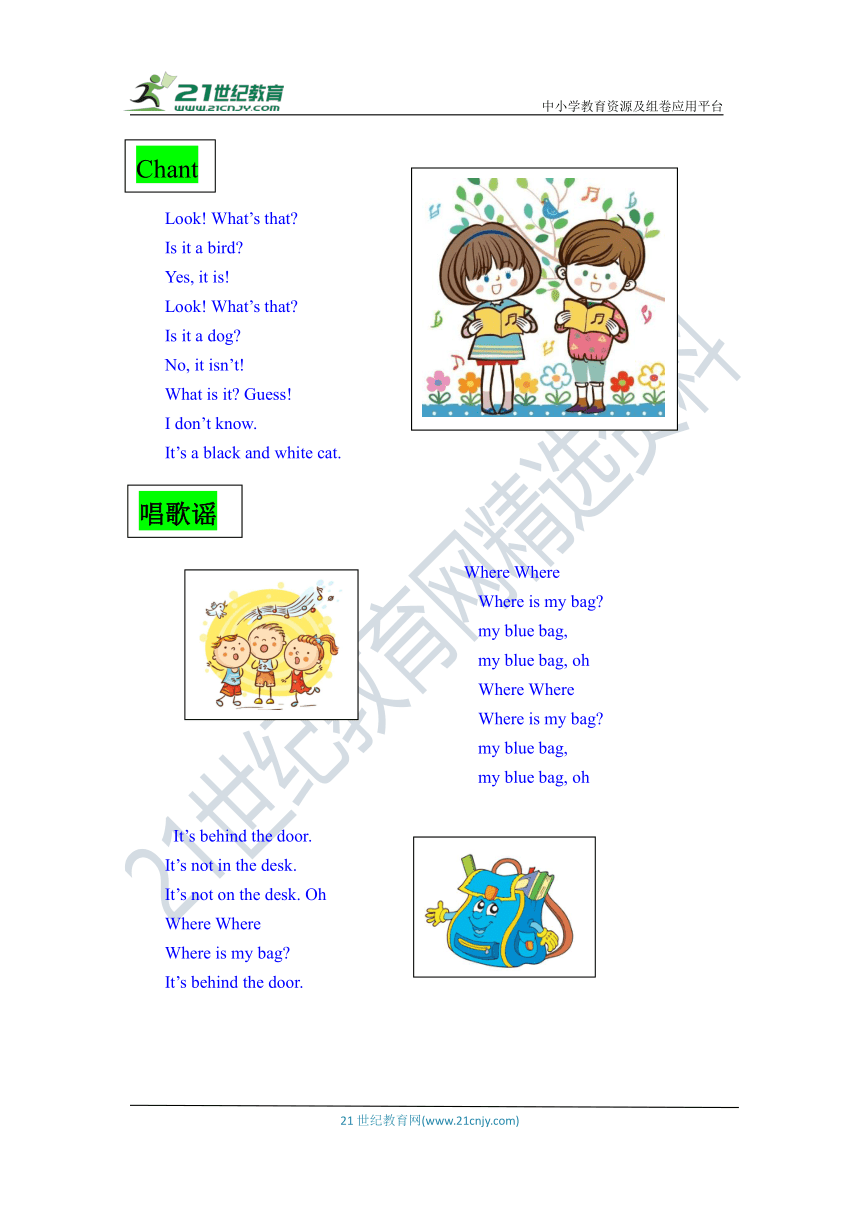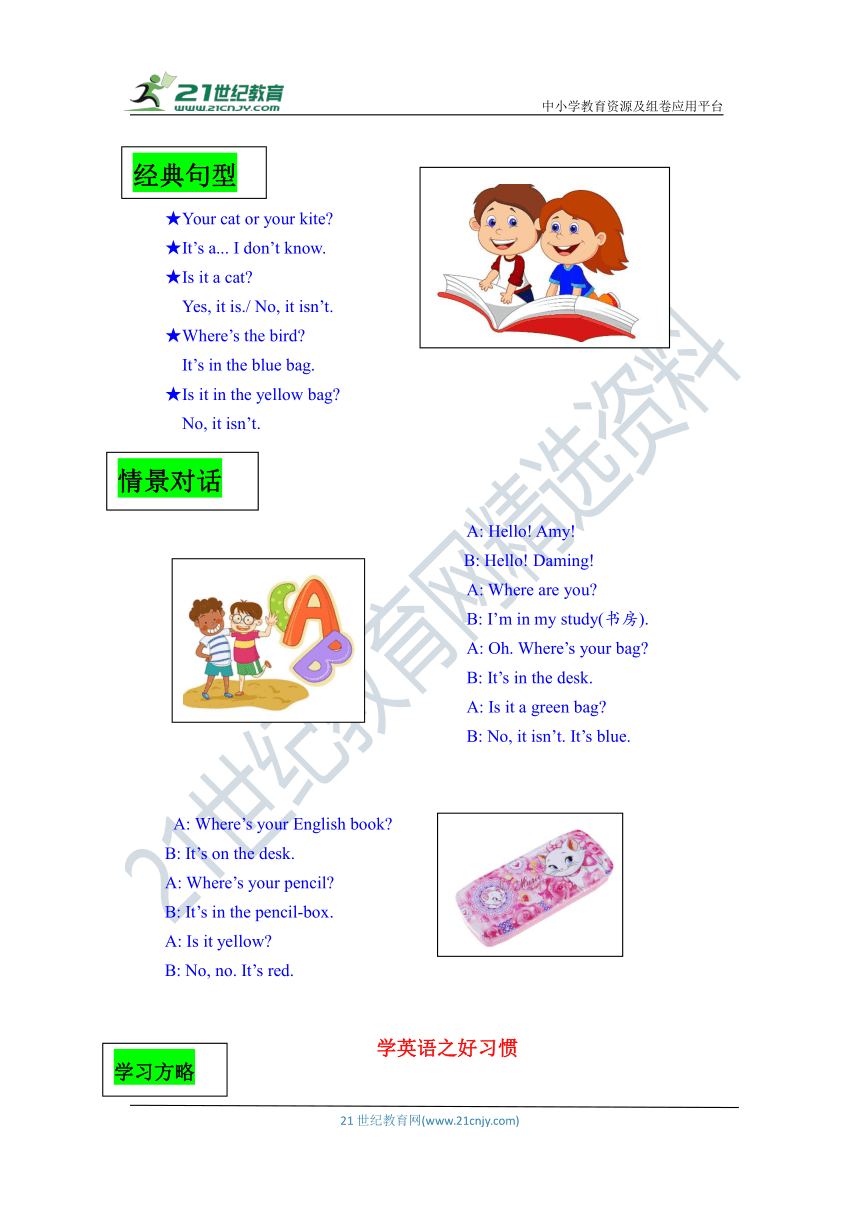外研版(三年级起点)三年级上学期用Module 8趣味英语读和练(含答案)
文档属性
| 名称 | 外研版(三年级起点)三年级上学期用Module 8趣味英语读和练(含答案) |  | |
| 格式 | docx | ||
| 文件大小 | 4.4MB | ||
| 资源类型 | 试卷 | ||
| 版本资源 | 外研版(三年级起点) | ||
| 科目 | 英语 | ||
| 更新时间 | 2021-11-25 15:42:57 | ||
图片预览



文档简介
中小学教育资源及组卷应用平台
Module 8
交际用语。对物品的推断进行询问。英语求救用语“Help!”。询问并回答物品的位置。一般疑问句。方位介词in。
能用英语对物品的推断进行询问,理解方位介词,询问并回答物品的位置。
通过看听说和游戏等活动,培养观察、辨别和合作交流能力。敢于开口,积极参与,乐于模仿和表达,提高英语口语交际能力。激发学习热情和兴趣,树立学习信心,培养自主学习的意识和思维能力。爱护物品。
方位介词
位置指人或物所在或所占的地方,或者所处的方位。
表示位置就会涉及到方位介词,方位介词就是指代方位的介词,表示事物存在的方向和位置。
方位介词有很多,常用的有:
在……上面,在……下面;在……前面,在……后面;在……里面,在……外面;在……左边,在……右边;在……旁边;在……附近;在……之间;在……周围;紧挨……等等。
方位介词是使用频率很高的介词,方位介词与其后面的人或物构成介词短语,表示人或物所处的具体位置。
有些方位介词的意义比较接近,但含义却不尽相同,在用法上很难区分,所以在运用是要弄清它们的细微区别。
Look! What’s that
Is it a bird
Yes, it is!
Look! What’s that
Is it a dog
No, it isn’t!
What is it Guess!
I don’t know.
It’s a black and white cat.
Where Where
Where is my bag
my blue bag,
my blue bag, oh
Where Where
Where is my bag
my blue bag,
my blue bag, oh
It’s behind the door.
It’s not in the desk.
It’s not on the desk. Oh
Where Where
Where is my bag
It’s behind the door.
★Your cat or your kite
★It’s a... I don’t know.
★Is it a cat
Yes, it is./ No, it isn’t.
★Where’s the bird
It’s in the blue bag.
★Is it in the yellow bag
No, it isn’t.
A: Hello! Amy!
B: Hello! Daming!
A: Where are you
B: I’m in my study(书房).
A: Oh. Where’s your bag
B: It’s in the desk.
A: Is it a green bag
B: No, it isn’t. It’s blue.
A: Where’s your English book
B: It’s on the desk.
A: Where’s your pencil
B: It’s in the pencil-box.
A: Is it yellow
B: No, no. It’s red.
学英语之好习惯
●每天坚持半小时读英语。
●养成听录音的良好习惯,并模仿录音,大声朗读。
●养成看见单词就自觉拼读的习惯,记单词要用心,常背常上心。
●养成用英语写句子、写话的好习惯。
●课堂上要注意留心老师的口型,听老师的发音,模仿老师的语音语调,并且
比较自己的发音是否与老师一致。
●熟读每篇课文,背诵部分课文。大胆自信地与同学老师用英语对话。
●作业字迹要工整,有不懂的地方,要勤问,勤查字典。养成正确使用大小写
和标点的习惯。
●课外阅读一些适合自己的英语读物,并摘抄一些常用单词,不断积累扩大自
己的词汇量。
稳操胜券的“in the bag”
当一个陌生习语摆在你面前,每个单词都是那么熟悉,但就是拿不准它的意思,望文生义是很不靠谱的,否则你就想歪了。
“in the bag”的字面意思是“在袋子里”,没错!请看下面的对话:
A: Where’s your book 你的书在哪儿?
B: It’s in the bag. 在袋子里。
◆书装在袋子里,不会错吧?
但是“in the bag”其实也是一个很常用的习语,作为一个习语,那“in the bag”究竟是什么意思呢?请看下面的对话:
A: We are twenty points ahead. 我们领先二十分。
B: The game is in the bag. 比赛取胜是稳操胜券(十拿九稳)的了。
◆书可以装在袋子里,比赛能装在袋子里吗?领先二十分,当然是稳操胜券(十拿九稳)的了。
所以,作为习语,“in the bag”的意思就是:稳操胜券;十拿九稳。
“kite”是猛禽吗?
英语单词“kite”来自古英语,原本是一种猛禽cyta(鹰;鸢)的名字,是模仿这种鸟的叫声来命名的,因飞翔的风筝如雄鹰展翅而得名。17世纪60年代,人们开始用“kite”来表示“风筝”,因为风筝在空中飞行的样子与“kite”这种猛禽很像。
Languages are to be learned only by reading and speaking.
语言只有通过读和说才能学会。
The way to learn a language is to practice speaking it as often as possible.
学习一门语言的方法就是要尽量多地练习说。
大家好,好英语是“说”出来的。看了上面的两句名言,你应该懂得在学习英语时“说”的重要性了吧?同学们,大胆说,随便说,尽管说!
同学们好,请你们在词典里查找下面句子里的生词,把下面的句子翻译成汉语,然后根据句子的意思,在横线上填一个英语单词。
Xiao Ming can’t swim, but he accidentally falls into the lake. Xiao Ming should call “ ______!”
我会选
( )1. — Is it a kite — ______ It’s a cat.
A. Yes, it is. B. No, it isn’t. C. Thank you.
( )2. — ______ — It’s in the blue bag.
A. Where’s the book B. What’s that C. What’s your name
( )3. — ______ — Yes, it is.
A. Is it a dog B. What’s this C. Where is it
( )4. — Where is the pen — ______
A. It’s green. B. It’s a pencil. C. It’s in the desk.
“考点演练”参考答案
Module 8
B 2. A 3. A 4. C
21世纪教育网(www.21cnjy.com)
Module 8
交际用语。对物品的推断进行询问。英语求救用语“Help!”。询问并回答物品的位置。一般疑问句。方位介词in。
能用英语对物品的推断进行询问,理解方位介词,询问并回答物品的位置。
通过看听说和游戏等活动,培养观察、辨别和合作交流能力。敢于开口,积极参与,乐于模仿和表达,提高英语口语交际能力。激发学习热情和兴趣,树立学习信心,培养自主学习的意识和思维能力。爱护物品。
方位介词
位置指人或物所在或所占的地方,或者所处的方位。
表示位置就会涉及到方位介词,方位介词就是指代方位的介词,表示事物存在的方向和位置。
方位介词有很多,常用的有:
在……上面,在……下面;在……前面,在……后面;在……里面,在……外面;在……左边,在……右边;在……旁边;在……附近;在……之间;在……周围;紧挨……等等。
方位介词是使用频率很高的介词,方位介词与其后面的人或物构成介词短语,表示人或物所处的具体位置。
有些方位介词的意义比较接近,但含义却不尽相同,在用法上很难区分,所以在运用是要弄清它们的细微区别。
Look! What’s that
Is it a bird
Yes, it is!
Look! What’s that
Is it a dog
No, it isn’t!
What is it Guess!
I don’t know.
It’s a black and white cat.
Where Where
Where is my bag
my blue bag,
my blue bag, oh
Where Where
Where is my bag
my blue bag,
my blue bag, oh
It’s behind the door.
It’s not in the desk.
It’s not on the desk. Oh
Where Where
Where is my bag
It’s behind the door.
★Your cat or your kite
★It’s a... I don’t know.
★Is it a cat
Yes, it is./ No, it isn’t.
★Where’s the bird
It’s in the blue bag.
★Is it in the yellow bag
No, it isn’t.
A: Hello! Amy!
B: Hello! Daming!
A: Where are you
B: I’m in my study(书房).
A: Oh. Where’s your bag
B: It’s in the desk.
A: Is it a green bag
B: No, it isn’t. It’s blue.
A: Where’s your English book
B: It’s on the desk.
A: Where’s your pencil
B: It’s in the pencil-box.
A: Is it yellow
B: No, no. It’s red.
学英语之好习惯
●每天坚持半小时读英语。
●养成听录音的良好习惯,并模仿录音,大声朗读。
●养成看见单词就自觉拼读的习惯,记单词要用心,常背常上心。
●养成用英语写句子、写话的好习惯。
●课堂上要注意留心老师的口型,听老师的发音,模仿老师的语音语调,并且
比较自己的发音是否与老师一致。
●熟读每篇课文,背诵部分课文。大胆自信地与同学老师用英语对话。
●作业字迹要工整,有不懂的地方,要勤问,勤查字典。养成正确使用大小写
和标点的习惯。
●课外阅读一些适合自己的英语读物,并摘抄一些常用单词,不断积累扩大自
己的词汇量。
稳操胜券的“in the bag”
当一个陌生习语摆在你面前,每个单词都是那么熟悉,但就是拿不准它的意思,望文生义是很不靠谱的,否则你就想歪了。
“in the bag”的字面意思是“在袋子里”,没错!请看下面的对话:
A: Where’s your book 你的书在哪儿?
B: It’s in the bag. 在袋子里。
◆书装在袋子里,不会错吧?
但是“in the bag”其实也是一个很常用的习语,作为一个习语,那“in the bag”究竟是什么意思呢?请看下面的对话:
A: We are twenty points ahead. 我们领先二十分。
B: The game is in the bag. 比赛取胜是稳操胜券(十拿九稳)的了。
◆书可以装在袋子里,比赛能装在袋子里吗?领先二十分,当然是稳操胜券(十拿九稳)的了。
所以,作为习语,“in the bag”的意思就是:稳操胜券;十拿九稳。
“kite”是猛禽吗?
英语单词“kite”来自古英语,原本是一种猛禽cyta(鹰;鸢)的名字,是模仿这种鸟的叫声来命名的,因飞翔的风筝如雄鹰展翅而得名。17世纪60年代,人们开始用“kite”来表示“风筝”,因为风筝在空中飞行的样子与“kite”这种猛禽很像。
Languages are to be learned only by reading and speaking.
语言只有通过读和说才能学会。
The way to learn a language is to practice speaking it as often as possible.
学习一门语言的方法就是要尽量多地练习说。
大家好,好英语是“说”出来的。看了上面的两句名言,你应该懂得在学习英语时“说”的重要性了吧?同学们,大胆说,随便说,尽管说!
同学们好,请你们在词典里查找下面句子里的生词,把下面的句子翻译成汉语,然后根据句子的意思,在横线上填一个英语单词。
Xiao Ming can’t swim, but he accidentally falls into the lake. Xiao Ming should call “ ______!”
我会选
( )1. — Is it a kite — ______ It’s a cat.
A. Yes, it is. B. No, it isn’t. C. Thank you.
( )2. — ______ — It’s in the blue bag.
A. Where’s the book B. What’s that C. What’s your name
( )3. — ______ — Yes, it is.
A. Is it a dog B. What’s this C. Where is it
( )4. — Where is the pen — ______
A. It’s green. B. It’s a pencil. C. It’s in the desk.
“考点演练”参考答案
Module 8
B 2. A 3. A 4. C
21世纪教育网(www.21cnjy.com)
同课章节目录
- Module 1
- Unit 1 I'm Sam.
- Unit 2 How are you?
- Module 2
- Unit 1 I'm Ms Smart.
- Unit 2 What's your name?
- Module 3
- Unit 1 Point to door.
- Unit 2 Point to desk.
- Module 4
- Unit 1 It's red!
- Unit 2 It's a black dog.
- Module 5
- Unit 1 How many?
- Unit 2 Nine girls?
- Module 6
- Unit 1 Happy birthday!
- Unit 2 How old are you?
- Module 7
- Unit 1 What's this?
- Unit 2 What's that?
- Module 8
- Unit 1 Is it a monster?
- Unit 2 Where's the cat?
- Module 9
- Unit 1 This is my mothe
- Unit 2 He's a doctor.
- Module 10
- Unit 1 This is his head.
- Unit 2 Point to her nose
- Review Module
- Unit 1
- Unit 2
